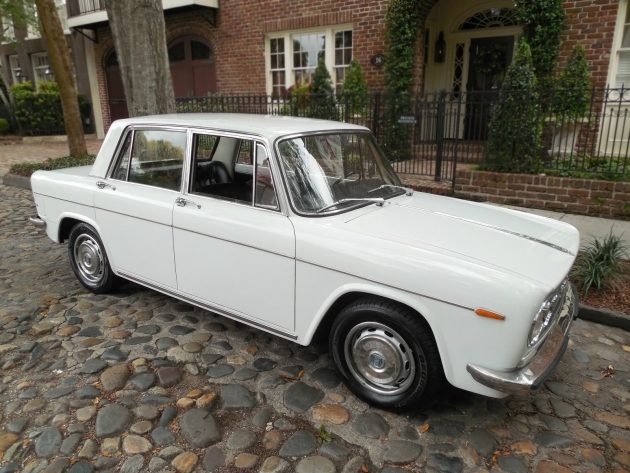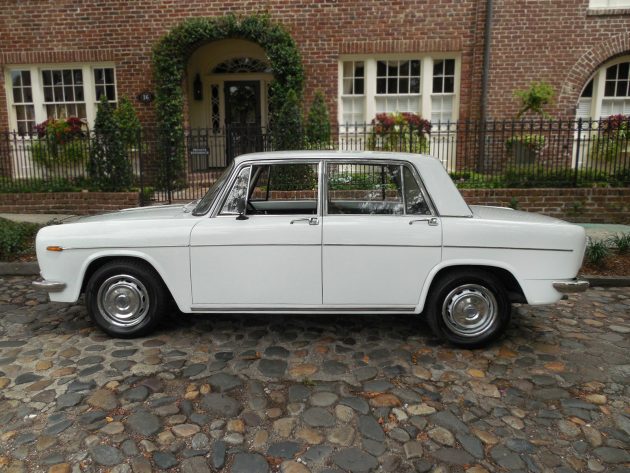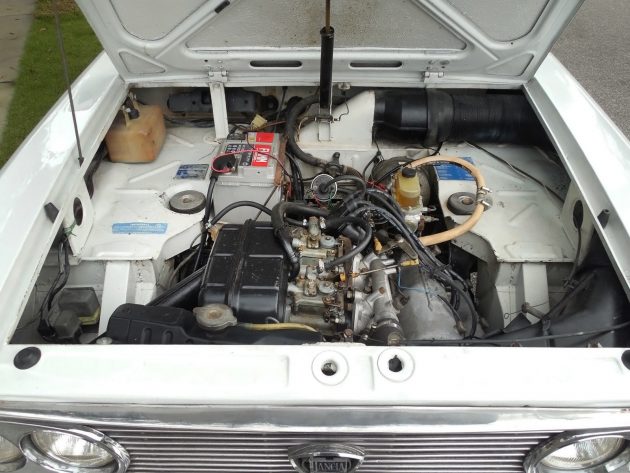Here’s one for you Italian car fans, it’s a 1971 Lancia Fulvia Berlina and it’s in Mount Pleasant, South Carolina. This cool but not-sleek Italian beauty is listed on eBay with a current bid price of $7,350 and there are less than two days left on the auction.
These Lancia Fulvias have always reminded me of the Alfa-Romeo Giulia, but the Alfa is rear-wheel-drive and this Lancia is front-wheel-drive, so the Alfa probably wins in the handling department. Although, in magazine reviews, Road & Track said about the Lancia Fulvia, “a precision motorcar, an engineering tour de force.” The Fulvia was made from 1963 to 1976 in three body styles: this four-door sedan, a two-door coupe, and a Sport, which was a fastback coupe designed by Zagato. Needless to say, the Sport would be the top-tier car to have out of the three, or if you’re like me, you’d want them all.
It sure looks like a roomy sedan, and it is. Design-wise, I absolutely love it, but I’m sure that some folks will scratch their heads as to why anyone would want a car that defines the three-box design maybe better, and more literally, than any other car has ever done. But, I think that most of you know that I live and breathe unusual vehicles. This is a car that a person most likely would never see at a car show, or at a Target store getting loaded with groceries, or in the drive-thru lane of a fast food joint. This car is outstanding in its field.. (sorry)..
Man, that looks comfy! This car has only 41,000 miles and it shows, it’s in fantastic condition. I wish that I could be in such fine condition after so many decades. The interior looks impeccable, other than a couple of cracks in the floor mats, but I’m assuming that those are original. I’m not sure if there is a floor mat restoration company out there, but I’d probably take those out and put them in the spacious trunk and then put them back down only when this beauty is at car shows. The dash, steering wheel, and seats are perfect, front and rear, as you’d expect from looking at the rest of this car.
Here’s the engine and it’s a double-overhead-cam, narrow-angle 1,298 cc V4 with about 85 hp. The 5-speed manual makes it fun to extract each of those 85 hp even with front-wheel-drive. The seller says that the “engine loves to be revved and responds instantly through its two solex carbs.” The Coupe version of the Fulvia won the International Rally Championship in 1972 so they’re nothing to sneeze at. I can’t think of one thing that I would change on this car, but I sure would love to have it. It would be a hoot to drive around town or take on road trips. Have any of you seen a Lancia Fulvia Berlina before? Or better yet, have any of you ever driven or owned one? And, if so, I’m jealous.







Lancias were always technically advanced designs. The first-ever unit body car was the Lancia Lambda in 1922. The first V6 engine was in the Lancia Aurelia in 1950. The first narrow angle V4 was also in the Lambda in 1922.
The narrow angle V4 that was used in this Fulvia was old stuff for Lancia by the time this car was made, and it was unusual. The V angle was only 13 degrees, so the cylinders weren’t in a line, but they were close. That allowed for a single head to cover the whole thing, almost like a straight 4 but with the cylinders alternating L-R-L-R. And as Scotty said, the engine had a DOHC valvetrain with one camshaft for the intakes and another camshaft for the exhausts. Then the whole thing was tilted over at 45 degrees.
These were front WD cars but Lancias always handled well, and these Fulvias did too. They were very upscale, high quality sporting cars, even the sedans, like the Italian counterpart to the small BMW sedans from decades ago, but with 4 doors instead of 2. A look at the carbs on the engine tells you that the seller is right when he says that the engine loves to be revved.
This car looks really good and has believably low miles. No underside shots, but I think the body and underside are probably OK given the overall condition of the car. Problem is, most people don’t know about these, and there is little market for them, so it’s good to see that a number of people are bidding and that it will be sold. If I were selling it I might be tempted to ship it over to Italy to sell it there, where there would be a lot of interest in it.
I’ve said it before and I’ll say it again, Lancias are wonderful to drive! Don’t know what it is exactly, it just feels right.
Just don’t ever get them wet, ever.
I don’t know why you say the Alfa would probably be the better handling car. The Fulvia like the SAAB 96 handles beautifully. Both were rally winners. Fulvia coupe even more so. RWD can be more fun but FWD is quicker on the really twisty stuff.
A Giulia will blow the Fulvia into the weeds on or off the track, twisties or straights. The second generation Fulvia with twin carbs (C2) could be considered as a sports sedan but only when compared to its single carb’d predecessor. This a Fulvia is a cool Italian sedan of that era but Alfa ruled the nest of Italian sport sedans, and not just Italian…
I’ve done a lot of Google searches looking for some engineering rationale for the narrow angle V-4. I’ve come up with very little that explains the advantages for application to automobiles. Volkswagen uses a narrow angle v-6 but according to what I have read, it was to enable packaging a 6 in the space of an inline 4, rather than a redesign of the platforms which use it.
Lancia was a supplier of Aero engines prior to and during WW1. Even then, frontal area was a design consideration and for that reason they used narrow angle V engines of several different cylinder counts. Sooo…….did they just continue using a design they understood when they started to produce cars after the war to end all wars? In today’s world tooling costs often dictate the retention of some design features in order to keep the investment manageable, but I rather doubt Lancia had any large investments in specialized tooling for boring blocks at a narrow angle. Ford at that time was the pioneer of tooling that was specialized for one particular engine design. I have seen films of machines which descend on a Ford flathead V8 block and virtually drill/bore and tap nearly every hole in the block at the same time.
That represents a rather large investment in tooling which is justified by the volume of production and the long lifespans of an engine design. Think of how long the Ford flathead V8 was produced, 1932- until (licensed to Simca) the late 70’s or possibly early 80’s. Or the Chevy small block, 1955 til sometime in the late 90’s. In fact, I think the current Chevy v-8 despite many changes still uses the same bore spacing.
In the late teens and 20’s Lancia, if I recall correctly produced several narrow angle engine with angles differing by only one degree between the two rows. So experimenting with so many angles and Lancia’s very low production volumes would not seem to me to suggest they had any large investments in specialized tooling.
So, I still want to understand their rationale for the narrow angle engine application for automobiles.
They are Italian, no such thing as “rationale”
A Greek friend of mine had his Fulvia since new for over 30 years. He surprised his family by trading it in one day for the newest Lancia. His family forced him to get the Fulvia back and he has it to this day.
Fabulous little driving cars when pushed, here are a couple of pictures of an earlier one. 1968 Series 1, Fulvia 2C, just as it came over from Italy last year to UK.
Series I has the 4 speed column change, leaving all that floor space, also the plainer dash with a revolving speedometer.
For those that could be interested, here is a picture of a coupe of the same age period, 1971 Fulvia SII 1.3S, which has again come from Italy and is for sale wit a number of other Lancia’s at, http://www.essexclassiccarauctions.co.uk
On the comparison between a 3 box Fulvia & the Alfa Giulia, the little 1300cc Super does also go well, again when pushed and is possibly better balanced with its rear wheel drive. Again here is a picture of a 1973 Series II Super, in a wonderful period color of, Faggio Brown for sale at http://www.essexclassiccarauctions.co.uk
Auction update: this fantastic car sold for $8,300.